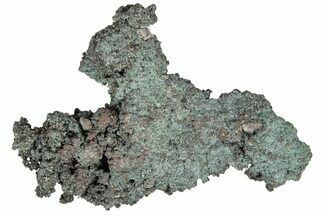.7" Rare Tongxinite on Native Copper - Germany
This is a .7" wide formation of native copper mined near Brumbach Creek in Saxony - Anhalt, Germany. The natural golden color of the specimen is a result of the formation of yellow tongxinite over the copper, a rare cooper-zinc mineral known from few locations.
Comes with an acrylic display case.
Comes with an acrylic display case.
Native copper is an uncombined form of copper that occurs as a natural mineral. Copper is one of the few metallic elements to occur in native form, although it most commonly occurs in oxidized states and mixed with other elements. Native copper was an important ore of copper in historic times and was used by prehistoric peoples.
Native copper occurs rarely as isometric cubic and octahedral crystals, but more typically as irregular masses and fracture fillings. It has a reddish, orangish, and/or brownish color on fresh surfaces, but typically is weathered and coated with a green tarnish of copper carbonate.
The mines of the Keweenaw Peninsula in Upper Michigan were major copper producers in the 19th and early 20th centuries, and are still the largest deposits of native copper in the world. Native Americans mined copper on a small scale at this and several other locations, and evidence exists of copper trading routes throughout North America among native peoples, proven by isotopic analysis. The first commercial mines in the Keweenaw Peninsula (which is nicknamed the "Copper Country" and "Copper Island") opened in the 1840s.
Native copper occurs rarely as isometric cubic and octahedral crystals, but more typically as irregular masses and fracture fillings. It has a reddish, orangish, and/or brownish color on fresh surfaces, but typically is weathered and coated with a green tarnish of copper carbonate.
The mines of the Keweenaw Peninsula in Upper Michigan were major copper producers in the 19th and early 20th centuries, and are still the largest deposits of native copper in the world. Native Americans mined copper on a small scale at this and several other locations, and evidence exists of copper trading routes throughout North America among native peoples, proven by isotopic analysis. The first commercial mines in the Keweenaw Peninsula (which is nicknamed the "Copper Country" and "Copper Island") opened in the 1840s.
$85
SPECIES
Tongxinite & Copper (Cu)
LOCATION
Brumbach Creek, Grillenberg, Sangerhausen, Saxony - Anhalt, Germany
SIZE
.7" wide
CATEGORY
ITEM
#317043
 Reviews
Reviews









